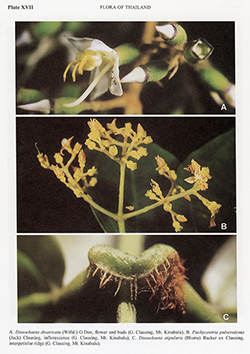e-Flora of Thailand
Volume 7 > Part 3 > Year 2001 > Page 423 > Melastomataceae > Dissochaeta
4. Dissochaeta divaricata (Willd.) G.Donwfo-0001280828
Gen. Syst. 2: 783. 1832; Naudin, Ann. Sci. Nat. Bot. 3, 15: 70. 1851.— Melastoma divaricatum Willd., Sp. Pl., ed. 4, 2: 596. 1799 ('divaricata’).— Anplectrum divaricatum (Willd.) Triana, Trans. Linn. Soc. London 28: 84, pl. 7, fig. 90b. 1871; Ridl., Fl. Malay Penins. 1: 800. 1922.— Diplectria divaricata (Willd.) Kuntze, Rev. Gen. Pl. 1: 246. 1891; Bakh.f., Rec. Trav. Bot. Néerl. 40: 200. 1943; Veldk. et al., Blumea 24: 417. 1978. Plate XVII: A.
Accepted Name : This is currently accepted.
Synonyms & Citations :
Description : Scrambling shrub or woody climber, branchlets floccose-puberulous or glabrous, with or without 2–3 mm long stellate hairs or bristles, interpetiolar ridges low, variously setose (the setae to 4.5 mm long), puberulous, or glabrous. Leaves ovate, oblong, or lanceolate, 6.5–13(–17) x 2.5–6.5(–8) cm, base rounded, apex acute to acuminate, tip ca 0.5 cm long, lamina with 1–2 pairs of lateral primary veins, mature above glabrous to sparsely puberulous, below variously puberulous with brown stellate hairs, glabrescent, petioles 0.5–2.0 cm long, often edged with 1–2 mm long setae. Inflorescences terminal or axillary many-flowered paniculate cymes, 6–30 cm long, stellate pubescent to glabrous, bracts 4–14 x 1–4 mm, leaf-like, margin with fine bristles, caducous. Hypanthium campanulate or urceolate, 4–6 mm long, furfuraceous and often tinged purplish-blue, calyx rim 1 mm high, truncate, ovary ½ to ¾ as long as the hypanthium, adnate to the hypanthium by 8 septs, stamen pockets extending to the base of the ovary. Petals oblong to obovate, 7–10 mm long, white, pale purple, or pinkish. Stamens 4, plus 4 staminodes, epipetalous (inner) stamens fertile, anthers S-shaped, 5–7.5 mm long, connective not prolonged below the anthers, dorsally with a triangular or bifid spur, ventrally minutely bilobed, outer stamens staminodial, trapezoid, 1.5–2.5(–4.5) mm long and with a ca 2 mm long ± filiform dorsal appendage. Berry ellipsoid, about 8 mm long, stellate puberulous or glabrous.
Thailand : NORTHERN: Phitsanulok (NW of Nakhon Thai – type of Dissochaeta stellulatum: Kerr 5870 -BK K), Uttaradit; EASTERN: Nakhon Ratchasima; SOUTH-WESTERN: Kanchanaburi; SOUTH-EASTERN: Chanthaburi, Trat; PENINSULAR: Ranong, Phangnga, Phuket, Nakhon Si Thammarat, Trang, Songkhla, Surat Thani, Yala, Narathiwat (hills W of Bachaw – type of D. patens: Kerr 7215 -BK K).
Distribution : Burma, Laos, Vietnam, Malay Peninsula (Penang – type of Melastoma glaucum), Sumatra, Java (type of M. cyanocarpon), Borneo.
Ecology : Along margins of evergreen forests, beside rivers, and along roadsides, 20–1,000 m alt (up to 1,600 m outside Thailand).
Vernacular : Khrong ton (คร้งต้น)(Surat Thani); phlong in (พลองอินทร์)(Trang).
Uses: Used in Pahang as a 'meroyan', that is, a decoction drunk during the first three days after childbirth. A hot decoction of the leaves or roots is also used to treat fevers (Veldkamp et al., op. cit.: 419) and against scabies (op. cit.: 416).
Notes: Dissochaeta divaricata is similar to D. conica (for differences see note under that species). According to Veldkamp et al. (Blumea 24: 420–421. 1978), it is unclear from where the type of this species, a specimen labeled KLEIN s.n. in the Willdenow herbarium (No. 8218), came and who collected it.

